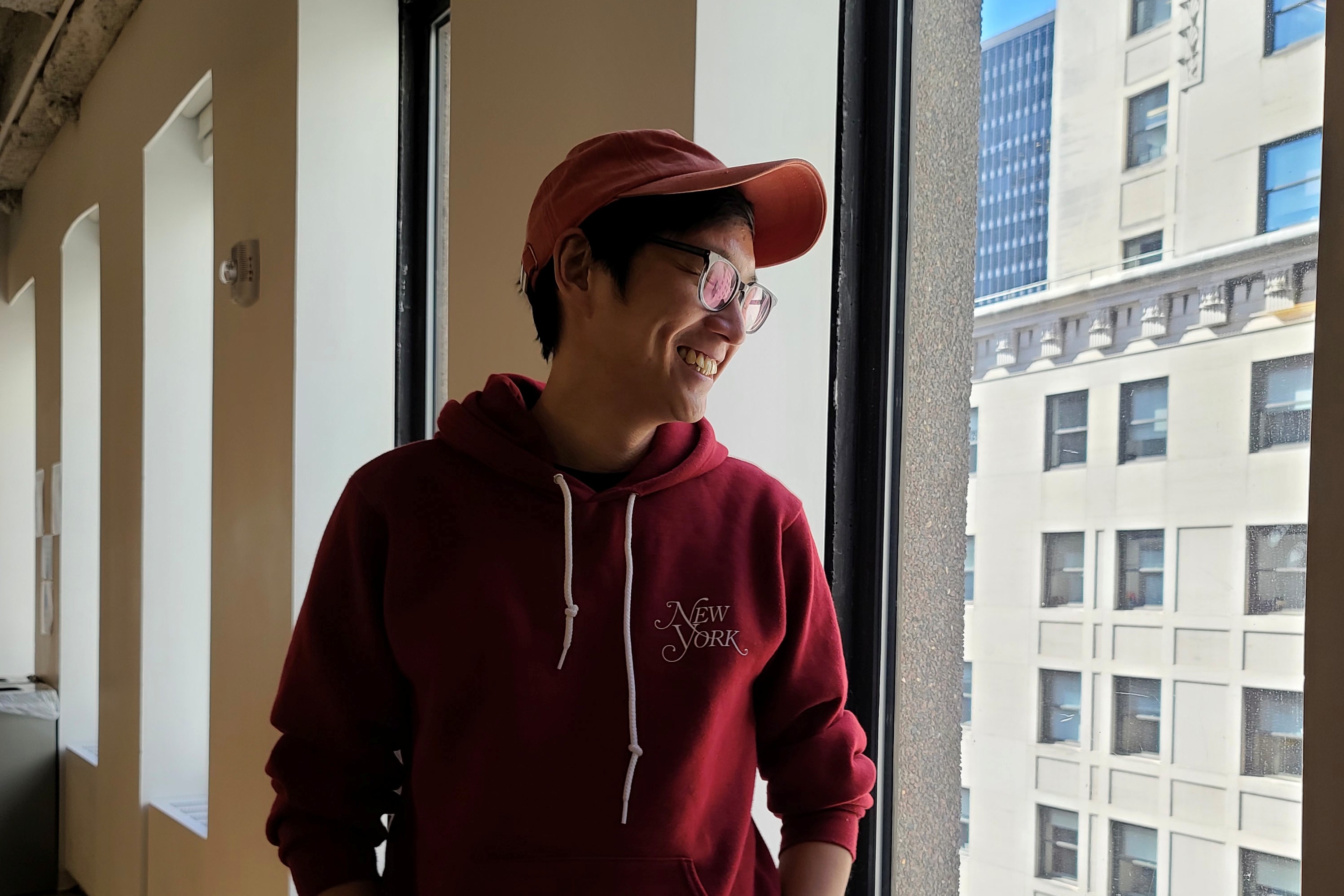
Samsung has something to prove.
That’s the most obvious feeling you get when using the Galaxy S20 Ultra, which will be available in March starting at $1,399.99. If there ever was an embodiment of the chip on a tech company’s shoulder, this behemoth of a phone is it. After a couple of years of lagging behind the iPhone and Android competitors in a few key areas, the Ultra is Samsung’s answer. It’s a Statement Phone, aiming to be the most powerful and best phone ever — price and size be damned.
There are many impressive things about the S20 Ultra: the screen, the battery, 5G networking, speed, and more. But the flagship feature is the all-new camera system, which features ultra-high megapixel counts and telephoto zoom in an attempt to kick off the next stage of mobile photography.
Samsung called this phone the S20 instead of the S11 to indicate that it is the first of a new generation, and that might be too revealing. As impressive as the overall phone is, the camera often acts like a first-gen tech product with first-gen tech problems.
Hardware, screen, and battery
The Galaxy S20 Ultra is big. There’s no getting around it. With a 6.9-inch screen, it’s taller and thicker than the iPhone 11 Pro Max. And although it technically weighs less, it feels more imposing, which may be a balance thing. I’m comparing it to that phone just because it might be more familiar to more people, but it towers over other plus-sized phones like the Pixel 4 XL, too.
The Ultra is also imposing in its looks, coming only in black or slate gray. The most prominent thing — physically and aesthetically — is the rectangular camera module on the back. It’s laid out with a grid of camera sensors and a flash in a symmetrical way, but unfortunately, Samsung couldn’t restrain itself from printing “SPACE ZOOM 100X” on it.
:no_upscale()/cdn.vox-cdn.com/uploads/chorus_asset/file/19750571/awhite_200223_3916_0488.jpg)
:no_upscale()/cdn.vox-cdn.com/uploads/chorus_asset/file/19750554/awhite_200223_3916_0425.jpg)
:no_upscale()/cdn.vox-cdn.com/uploads/chorus_asset/file/19750555/awhite_200223_3916_0371_vrt.jpg)
It is well-made in that typical Samsung Galaxy way, with curved glass on the front and back — though, this time around, the front is a little less curved at the edges than the back. All of the buttons are on the right-hand side; thankfully, the dedicated Bixby button from previous Galaxy phones has been omitted. I’d say the buttons are hard to reach, but the truth is if you’re trying to use this phone one-handed, you’re fooling yourself.
It’s glossy and slick, and it shows fingerprints. You probably see the fingerprint criticism a lot, but it’s worse than usual here. That huge camera module makes the phone wobble on a table if you tap near the top of the screen. It also picked up a mysterious ding somewhere along the line. The moral of all of these observations is, unfortunately, the same: get a case.
There are several reasons why this phone is so big, but the most obvious one is to give you that 6.9-inch screen. It’s easily the most impressive feature on the S20 Ultra. Because Samsung uses an in-screen fingerprint sensor instead of face unlock cameras, the screen can go all the way to the edge of the top of the screen, which makes it look bigger still. There’s just a small, centered hole-punch for the selfie camera.
This screen is also one of the reasons I think the S20 Ultra shows Samsung is trying to prove something: it is offering a 120Hz refresh rate option. High refresh rates make animations and scrolling look much smoother and can also help with compatible games. We saw a few Android phones try it last year, but the S20 is taking it mainstream this year.
Unlike other companies, Samsung isn’t trying to dynamically change the refresh rate based on what’s the screen. It comes out of the box at 60Hz, and when you set it to 120Hz, it just locks there. The reason you might want the rate to be variable is to save battery, but Samsung claims it’s about a 10 percent hit on battery life.
I’ll be honest: I don’t know whether that’s true or not because I turned on the 120Hz option right away and never looked back. It makes the experience of using Android so much better and smoother that I couldn’t bring myself to turn it off.
The 120Hz screen isn’t the only thing that could affect battery life, though. In fact, gauging battery life for the S20 Ultra is a particular challenge because there are so many variables in how people will use it. Shooting 4K and 8K video will drain the battery fast, as will mmWave 5G (if you can find it), as will intensive gaming. I think a lot of people will buy this phone to do those things and more.
There’s one more thing that may affect the battery: a new processor. The S20 Ultra has the new Qualcomm Snapdragon 865, which doesn’t have an integrated cellular modem. Previous Snapdragons have, and that typically is seen as a battery-saver.
I think Samsung figures it can handle all of these potential battery killers just by using a bigger battery, 5,000mAh. In my testing, that battery came through. I got through a day’s worth of moderate to even heavy use multiple times in the past week. Big phones usually do better on battery life, and even with 5G, lots of video watching, and plenty of camera use, the S20 lasted a day and cleared six hours of screentime.
Samsung may have made one concession to battery life with the high refresh rate option: when you turn it on, you are forced to bring the screen to its default resolution of 2300 x 1080, even though the display can support 3200 x 1440. I think the trade-off is worth it even at this screen size, but you may opt to go the other way.
Otherwise, the screen is typical for Samsung, which is to say it’s excellent. I set the color profile to natural and turned off the blue light filter to make the colors a little less garish. You can take all of the other screen quality metrics for granted: it looks great at any angle, indoors, outdoors, and it also supports HDR10+.
:no_upscale()/cdn.vox-cdn.com/uploads/chorus_asset/file/19750556/awhite_200223_3916_0459.jpg)
Camera
But really, Samsung has already won the “make a bigger phone with a bigger screen than anybody else” game multiple times. That’s not what the Galaxy S20 is all about. The most important new feature is the new camera system. Here, more than anywhere else, Samsung is trying to leap ahead of the competition by using a new kind of technology for smartphone cameras.
The S20 Ultra has five cameras, if you count the depth sensor on the back. Most of them feature very high megapixel counts: 40 on the selfie camera, 48 on the telephoto, and a whopping 108 megapixels on the main wide-angle camera. The ultrawide camera is the only one with a more traditional 12-megapixel sensor.
I’m going to belabor the technical details (and you can dig deeper here or here) because Samsung’s theory of the camera is that these sensors allow for photos that phones wouldn’t otherwise be able to take.
Those big megapixel counts form the core of Samsung’s camera bet. Historically, anything over 16 megapixels or so was a sign that the camera would be bad because more megapixels means they’re more tightly packed on the sensor, and so they can collect less light and end up with more noise. Samsung, however, has a couple of solutions to this problem.
:no_upscale()/cdn.vox-cdn.com/uploads/chorus_asset/file/19750701/20200223_112349.jpg)
:no_upscale()/cdn.vox-cdn.com/uploads/chorus_asset/file/19750612/20200223_102348.jpg)
The first and simplest is that the sensor is physically larger than before. The second and more important solution is “pixel binning,” wherein individual pixels are grouped together to act like one bigger pixel. This method has been around on phones before, but Samsung being Samsung is going bigger by combining nine of them. So by default, the 108-megapixel sensor outputs 12-megapixel images — and this so-called “nonabinning” happens directly on the sensor hardware.
Now that we’ve got all that under our belt, how is the photo quality? Mixed.
Let’s start with what’s good.
The thing you often hear about smartphone cameras is that they can take good photos in good lighting conditions, and that’s obviously the case with the S20 Ultra. Samsung’s penchant for cranking up vibrancy holds in good stead outdoors with landscape shots, and it does get good detail and sharpness in those situations.
Samsung is also doing a better job than it ever has with low-light photos. It’s compensating for those 108 megapixels quite well, I think, but its software tuning still can’t hold up to the Pixel 4’s Night Sight mode. The story is similar with portrait mode: Samsung has improved on previous Galaxy phones, but its blur looks more artificial than the iPhone 11 Pro.
Running around the city and taking photos of architecture, plants, landscapes, and art was a blast. I loved the results during the day and night, with results only breaking down when it got super dark. Samsung’s color tuning tends to be a little warmer and yellower than I like, but not wildly so.
:no_upscale()/cdn.vox-cdn.com/uploads/chorus_asset/file/19750621/20200223_113015.jpg)
:no_upscale()/cdn.vox-cdn.com/uploads/chorus_asset/file/19750620/20200221_185209.jpg)
:no_upscale()/cdn.vox-cdn.com/uploads/chorus_asset/file/19750619/20200221_184802.jpg)
:no_upscale()/cdn.vox-cdn.com/uploads/chorus_asset/file/19750618/20200223_103507.jpg)
The headline feature is zoom, and there’s one more technical detail that matters for that. The telephoto lens on the S20 Ultra is a “folded” lens, meaning that light hits a prism and mirror system that runs it through a kind of periscope before it hits the sensor. The so-called “Space Zoom” allows you to go as much as 100X through a mix of that periscope, taking multiple photos, and sensor cropping.
The result is true optical zoom up to 4X and quite good zoom up to 10X. (Samsung claims it’s “lossless,” but I wouldn’t go that far.) I tested it up against a Pixel 4 XL, iPhone 11 Pro, and a Sony RX100m7, a high-end point-and-shoot camera with a zoom lens.
The Pixel 4 (which has its own fancy zoom algorithms) maxes out at 8X, so let’s focus on that zoom level. The Sony standalone wins, of course, but when you look at the phones, you’ll see that Samsung’s claims are borne out. It’s clearer and sharper than the Pixel 4, and it embarrasses the iPhone, which is artifact city at this zoom level.
At 30X, I did get decent photos out of the S20 Ultra, but they looked very processed and phone-like. If I were Samsung, I would have stopped there. That’s because, at 100X, images are a splotchy mess; it’s good mainly as a party trick.
:no_upscale()/cdn.vox-cdn.com/uploads/chorus_asset/file/19750638/20200223_075641.jpg)
:no_upscale()/cdn.vox-cdn.com/uploads/chorus_asset/file/19750639/20200223_075649.jpg)
:no_upscale()/cdn.vox-cdn.com/uploads/chorus_asset/file/19750640/20200223_075657.jpg)
:no_upscale()/cdn.vox-cdn.com/uploads/chorus_asset/file/19750642/20200223_075809.jpg)
Samsung does deserve credit for making a camera interface that wrangles all of these options into something easy to use and understand. I also give Samsung credit for a new mode called “Single Take,” which lets you just hit the shutter and wait while the camera collects enough data to give you a bunch of different camera effects at once. Samsung has a lot of weirdo camera features, and it’s impossible to remember them all, so Single Take just does them for you. The quality isn’t the best, but it’s super fun.
Samsung’s other selling point for the S20 Ultra is that you can take full 108-megapixel photos, allowing you to crop way in to specific details if you want. (There’s yet more technical underpinning you could dig into here involving subpixel arrangements and re-mosaicing processes.)
Samsung thinks it’s best for landscapes and suggests that you only use it when the scene is brightly lit. I suggest you don’t use it nearly at all. I’ve yet to take a photo that looked better as a 108-megapixel photo than it did as a 12-megapixel one. On very tight crops, you can see more detail on some 108-megapixel shots, but you can also see enough noise that it’s only a modest improvement over the 12.
Now, the bad part.
The problem arises with faces. Like the iPhone, the S20 Ultra seems to see a face and wants to do a different kind of photo tuning to make sure it looks good. The S20 Ultra brings up shadows on faces and sometimes on the whole scene, it tries to adjust white balance differently, and it smooths out skin.
None of those are bad ideas in principle, but in practice, Samsung’s algorithms are trying way too hard. The aggressive brightening is ham-fisted. The skin smoothing is out of control in a lot of cases. I don’t know what’s going on with white balance at all. I’ve seen photos go haywire with cyan a lot and sometimes with yellow tones, too. The good news is the S20 Ultra doesn’t fall in the trap of making things worse with darker skin tones, at least.
These effects don’t happen every time with faces, but they happen often enough that it’s troubling. I’ve asked Samsung about it, and other than gesturing to the possibility of a future software update, there’s not really a clear answer for it.
There are no settings to turn off this smoothing on faces. In fact, Samsung’s “Bixby Scene Optimizer” setting tends to make it worse. What’s wild about all of this is that none of it is really necessary. If your subject turns their head 45 degrees, suddenly, the S20 stops doing all three of those things, and the photos come out really good. Similarly, if you switch into Samsung’s “Pro mode” in the camera app, these problems disappear.
:no_upscale()/cdn.vox-cdn.com/uploads/chorus_asset/file/19750683/20200223_074026.jpg)
What’s even wilder is that the selfie camera has a bunch of face-smoothing settings, and when you turn them off, you get much better photos of faces than the rear camera. Sincerely, the 40-megapixel front-facing camera is one of my favorite selfie cameras I’ve ever tested. It kicks out 10-megapixel photos by default, but, as with the rear camera, you can set it to give you the full 40 if you want.
There’s another, potentially more worrisome problem with the main rear camera: focus hunting. At first, I assumed that my blurry faces were simply a result of user error. (Often, that’s the case with new, unfamiliar cameras!) But Input and PCMag reported the same problem, and I’ve repeated the problem now with video tests. The phone just takes a half a tick longer to grab focus than it should, and when shooting video, it’ll lose focus and have to hunt for it again.
The focus issue seriously undercuts shooting video, which is a bummer because, otherwise, Samsung has an easy claim to make as the best video camera on an Android phone — and it might even be able to take on the iPhone for quality.
Samsung’s splashy video feature is the ability to shoot and edit 8K video, and the S20 Ultra can do both. It’s an accomplishment but not something I’d recommend most people do, though the ability to pull out high-quality stills from that footage is neat. The slightly improved video stabilization is more important to me (even though it locks you into shooting at 1080p).
In theory, Samsung can address some of my concerns with the camera via software updates. In fact, on the eve of this review, it got back to me with a statement saying it would do just that:
The Galaxy S20 features a groundbreaking, advanced camera system. We are constantly working to optimize performance to deliver the best experience for consumers. As part of this ongoing effort, we are working on a future update to improve the camera experience.
That’s heartening but only to a point. As a phone reviewer, I’ve heard promises that a software update would fix camera issues many times before, and it rarely pans out.
Earlier, I referred to this camera as having first-gen tech issues, and I think that’s basically the root of the problem. The hope is that Samsung is trying so many new things that it missed some details.
:no_upscale()/cdn.vox-cdn.com/uploads/chorus_asset/file/19750565/awhite_200223_3916_0012.jpg)
5G
The S20 Ultra and the rest of the S20 line are the first truly mainstream 5G phones. By the time the year closes, there will be dozens more because the newest Qualcomm chipsets Android makers are likely to use will essentially require it.
To again oversimplify the technical details, there are two kinds of 5G to know about. There’s midband, which works a lot like the traditional 4G signals you’re used to. Then there’s mmWave, which can be much faster but has a range that’s barely longer than a good Wi-Fi signal and can’t penetrate buildings.
:no_upscale()/cdn.vox-cdn.com/uploads/chorus_asset/file/19750562/awhite_200223_3916_0181_vrt.jpg)
I tested two networks in New York City: T-Mobile and Verizon. As of this writing, AT&T 5G should work on the S20 Ultra but has not yet been officially certified. The S20 Ultra did its end of the job with 5G, happily downloading bits as quickly as the network was able to deliver them.
On T-Mobile, I saw 5G speeds that ranged from barely better than LTE all the way up to 120 Mbps, which is quite fast. On Verizon, once, I found a street corner with 5G (no easy feat), and I got download speeds between 800 and 1,400 Mbps, which is stupid fast. However, I could also walk 50 feet, and the 5G signal would drop. Or I could just turn around and put my body between the phone and the cell tower to slow down the signal. I could even simply stand in one spot and wait, and 5G would occasionally drop.
That’s the state of 5G right now. It hasn’t lived up to the outsized promises that have been made about it for the past couple of years. It may someday, but the buildout is going to take much longer than we’ve been led to think.
T-Mobile’s 5G didn’t appear to significantly affect battery life, but as I noted above, the S20 Ultra has battery to spare. Verizon’s more intensive mmWave signal can have a noticeable impact, but you can solve that by simply walking away from the tower and dropping to LTE.
My advice: don’t buy the S20 Ultra just because it supports 5G. In fact, I don’t think you should buy any phone just because it supports 5G. At some point in the future, you’ll upgrade to a phone that has it, and if you have the right carrier in the right city, you’ll get faster speeds. It will be nice, but it’s not worth seeking out yet.
:no_upscale()/cdn.vox-cdn.com/uploads/chorus_asset/file/19750560/awhite_200223_3916_0314.jpg)
Performance and software
Because of Qualcomm’s cadence for releasing new processors, Galaxy S phones often have the benefit of being the first mainstream phones with the latest chips for Android. The Galaxy S20 Ultra is no exception. It has the Snapdragon 865 processor, which is a little controversial because it has a separate 5G modem instead of an integrated 4G one.
The S20 Ultra is plenty fast — as fast as any Android phone I’ve used — and given how many pixels it has to render and how quickly, I suppose that’s an achievement. But it doesn’t feel significantly different in day-to-day use than last year’s Snapdragon 855.
Samsung loves winning spec fights, and it’s easy to dismiss most of it as chest-thumping. But there are two that I think will matter for most users: the aforementioned 5,000mAh battery and the 12 or 16GB of RAM. The big battery helps paper over whatever issues might arise from 5G or the high refresh rate screen, and the extra RAM keeps apps from closing in memory. Both are sledgehammer solutions, but I’m not complaining.
The S20 line also has a new feature that lets you “pin” three or five (depending on your RAM) apps to memory so that Android will never close them in the background. It’s a power user feature, but then again, the Galaxy S20 Ultra is clearly a power user phone.
Samsung kept expandable storage around but got rid of the headphone jack. Yes, even in 2020 it’s okay to feel a little sad about the headphone jack, especially since last year’s Galaxy S10 kept it around.
One UI 2 is the name of Samsung’s custom software on top of Android 10, and, as ever, I think it makes some smart improvements on the default interface. There’s actual screen recording, easier-to-reach content, and a sidebar you can swipe in from anywhere that can contain your calendar, clipboard history, the weather, or other useful widgets. All of that is great.
Unfortunately, Samsung has apparently decided that it no longer needs to exercise restraint in its software additions. After years of paring TouchWiz back to something that felt more like stock Android, Samsung is Samsunging again. The left of the home screen is called “Samsung Daily,” and it’s a sad pile of information widgets from companies Samsung happens to partner with. Bixby is still a subpar voice assistant that is mapped to a long press of the power button. The Quick Settings tray is filled with arcane icons labeled with feature names you need a bachelor’s degree in Samsung feature creep to identify.
You can dial all of this back and clean it up, but being forced to do so is annoying for experts like me and will be positively mystifying for people who are new to Samsung.
:no_upscale()/cdn.vox-cdn.com/uploads/chorus_asset/file/19750564/awhite_200223_3916_0077.jpg)
The Galaxy S20 Ultra is a no expense spared, no stop un-pulled kind of phone. Samsung set out to show that it could outdo every other Android phone on the market. A lot of them have been creeping up on the Galaxy: the OnePlusses that beat it to high refresh rate screens, the Huaweis with their periscope lenses, and, of course, the Google Pixels’ computational photography.
The S20 Ultra is Samsung’s answer to all of them. And for the most part, it’s a very good answer. It’s fast, powerful, beautiful, and has a battery that lasts. It’s also, of course, very expensive: you’re paying for 5G and a big screen in that $1,399.99 starting price, but you will be able to find both of those things for much less money in other Android phones. To me, the main justification for that expense is the all-new camera system.
Unfortunately, all-new is very close to too-new, and the S20 Ultra’s cameras feel like the latter. Samsung’s new hardware for its cameras may give it an edge someday, but right now, it hasn’t fully wrangled all of those pixels with its software. That means that while it’s very competent, it’s also very inconsistent.
It’s worth waiting to see if Samsung can update its camera software to resolve the focus and face issues. I’ve asked for comment on if one is coming and will update this review if and when it does. Until then, Samsung has certainly proved that it can make a fast, powerful, imposing phone. It also proved that, once again, it can get caught assuming that powerful hardware is enough.
Vox Media has affiliate partnerships. These do not influence editorial content, though Vox Media may earn commissions for products purchased via affiliate links. For more information, see our ethics policy.
Author: Dieter Bohn.
Source: Theverge








